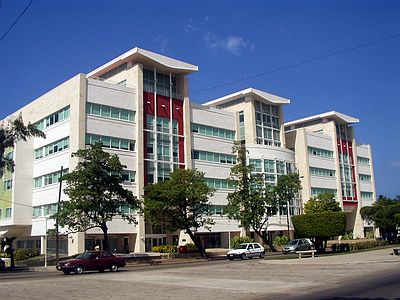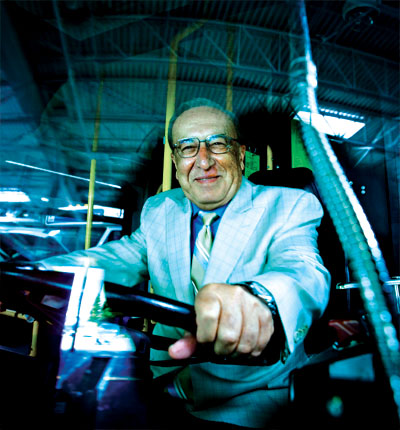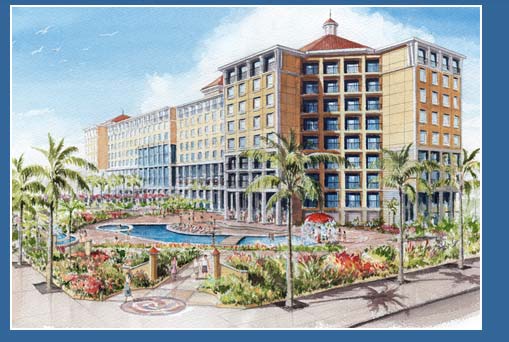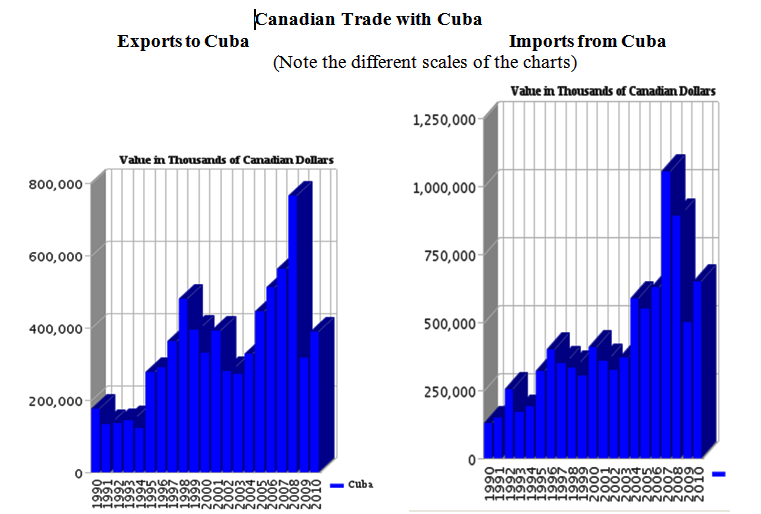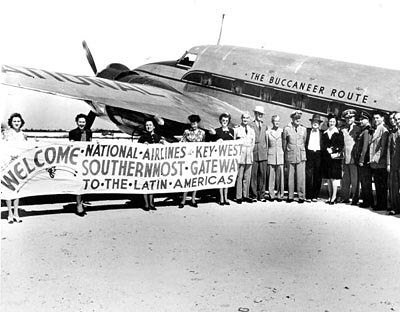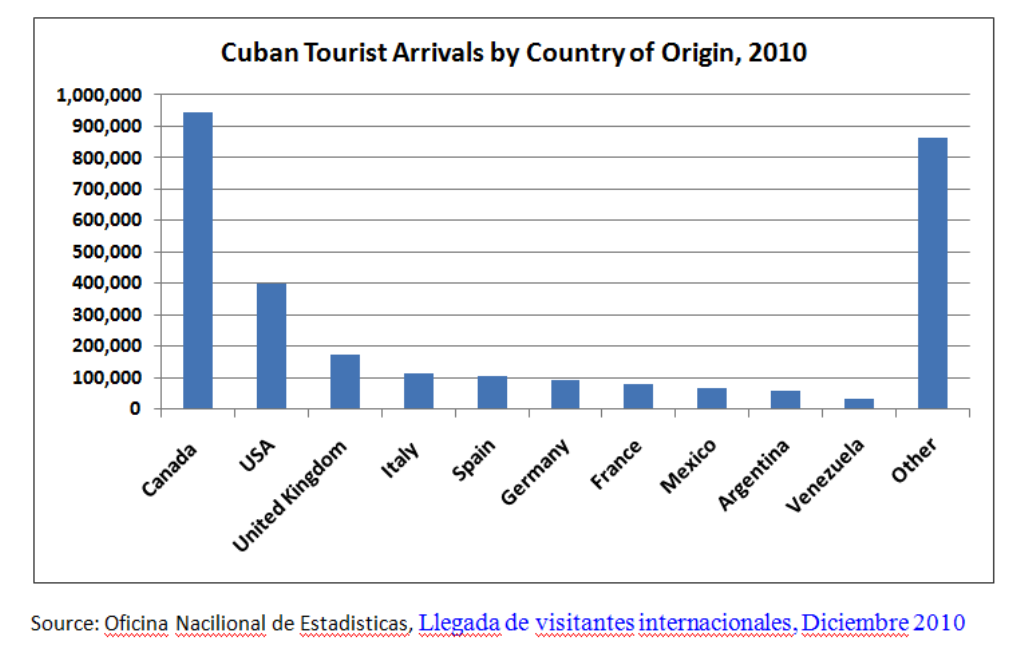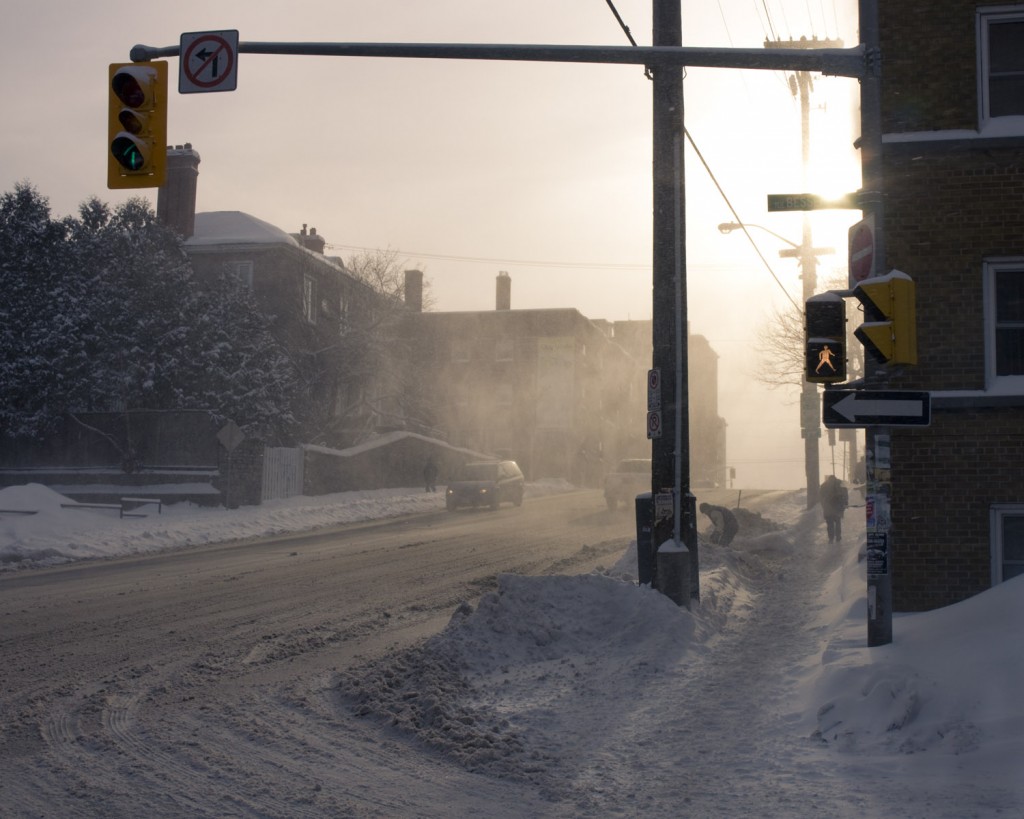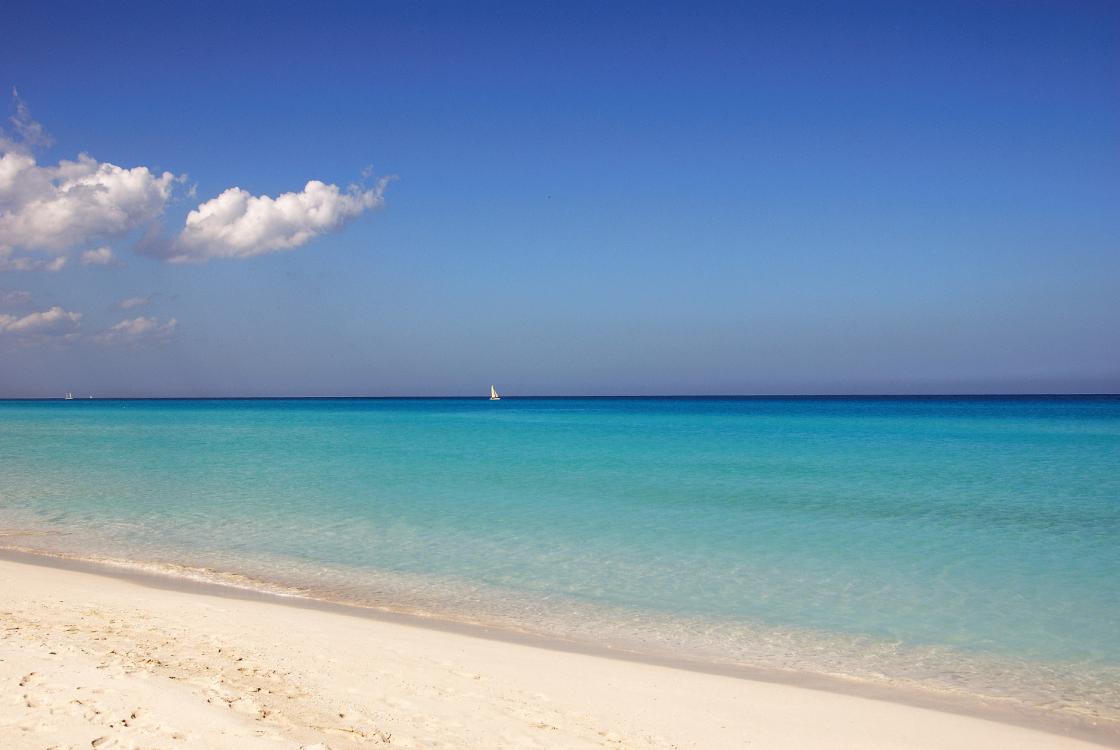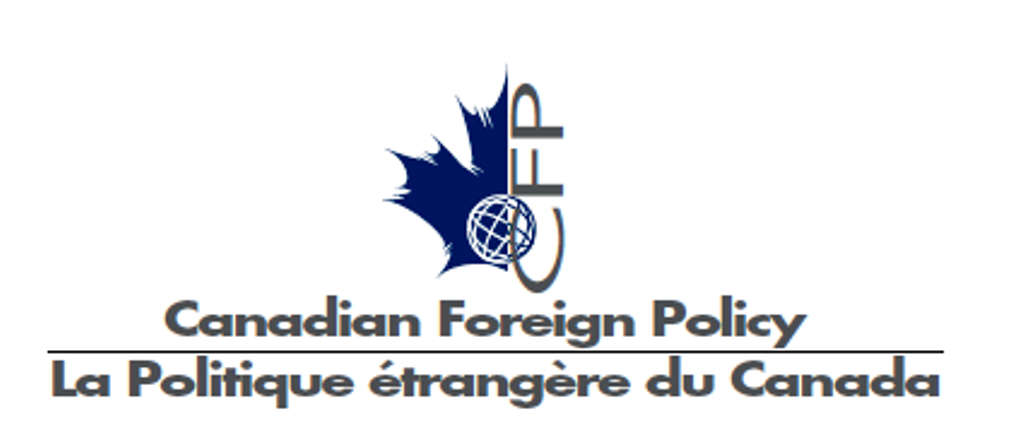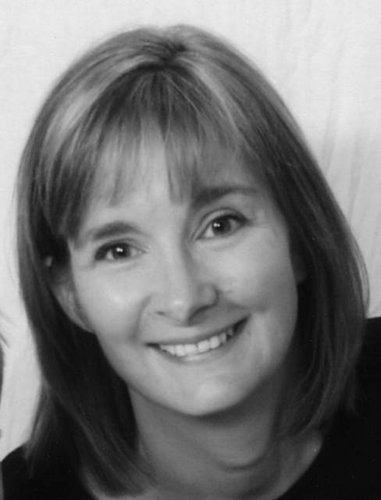By Arch Ritter
I. Initiation of the Joint Havana-Carleton Universities Economics MA
As the Cuban economy was sinking into the nadir of its depression following the ending of the “Special Relationship” with the former Soviet Union, the Faculty of Economics at the University of Havana decided that the time was right to introduce conventional economics into University curricula and into Cuba generally. With the collapse of the Soviet Union and the transition to mixed economies throughout Eastern Europe and the Soviet Union, the Soviet version of the discipline of Economics virtually disappeared. Cuban economists were left orphaned with a discipline that had become extinct. They generally were unfamiliar with the near-universal language of economics and found it difficult to communicate in the discipline with their colleagues in Latin America and the rest of the world.
This move to introduce conventional economics was spear-headed by Dra. Lourdes Tabares, who was the Chair of the Economics Department at the University of Havana at the time. It had broad though far from unanimous support within the University.
A meeting was arranged in early December 1993 in Havana to discuss alternative approaches to accelerating the process of developing instruction in conventional economics. Financed by the International Development Research Centre (IDRC), and coordinated by Dr. Gary McMahon, this meeting brought together a number of academics and officials from Chile and Argentina and me from Canada, with University of Havana counterparts.
A decision was reached at that meeting to organize a joint MA program in Economics mainly for young faculty members from Cuban Universities to be given in Cuba at the University of Havana. An agreement was subsequently reached between the President of Carleton University, Dr. Robin Farquhar and the Rector of the University of Havana. Juan Vela, to provide the Carleton program adapted to the circumstances of Cuba.
The program was conceived in December 1993 and was up and running six months later in Havana.
The Economics MA was financed for the first two years by the IDRC and was supported by Gary McMahon and Pierre Beemans. Following that, the Canadian International Development Agency (CIDA) financed another three years of the MA Program. The program received crucial support from the United Nations Economic Commission for Latin America (UN ECLAC), which lent its good name as a co-sponsor of the program and provided about 40% of the faculty at its own expense. Particularly vital was the support of Francisco Leon and the Secretary General Gert Rosenthal of UN ECLAC. The Canadian Embassy in Havana, notably through Ambassador Mark Entwistle and Nobina Robinson, were instrumental in the extension of the program. CIDA was so pleased with the first two IDRC-financed years that it decided to extend the Economics MA for an additional three years.
It also agreed to expand collaboration between Carleton University and the University of Havana for five years and to five other units at the two Universities: Biology, Business, Linguistics, Women’s Studies and Public Administration. Professors were recruited from a number of Latin American countries as well as Canada. Among the contributing professors were
- Canada: Keith Acheson, Zhiqi Chen, Donald McFetridge, Gary McMahon, Carl McMillan, Soo Bin Park, Simon Power, Arch Ritter, Nicholas Rowe, Larry Willmore (also with the United Nations), and Frances Woolley.
- UN ECLAC: Ricardo Ffrench-Davis, Michael Mortimer, Bernardo Kosakoff Juan Carlos Lerda, Luis Felipe Jimenez, , Jorge Katz, , Joe Ramos, Daniel Titelman.
- Argentina: Jose Maria Fanelli. Mario Damill, Guillermo Rozenwurcel
- Bolivia: Juan Antonio Morales
- Brazil: Ricardo Paez de Barras
- Peru: Alberto Pasco-Font
Senior Cuban professors worked with the visiting Canadian and Latin American professors and took over some of the classes. Among the Cuban professors were Felix Marero, Elena Hernandez, Lourdes Tabares, Nelida Gancedo, Vilma Hidalgo, Manuel Miranda, Frank Hidalgo, Ela de Quezada, Raul Sandoval, Celia Fernandez, Ermida Gonzalez and, and Marta Madero.
II. Impacts of the Program
The objective of the five years of the MA Economics Program was to support the introduction of conventional economics into the curriculum of Cuba’s universities. From this perspective, I think that it could be considered to have been reasonably successful. At the University of Havana for example, a program in conventional economics was initiated quickly and is in operation. Similarly the University of Oriente soon established a conventional economics program, under the leadership of the MA graduate Ulisses Pacheco who became Dean of the Faculty. These programs have been producing some impressive graduates and new academics for over a decade.
A substantial number of the MA graduates went on to earn Doctoral degrees in Economics both inside Cuba, notably in a program with the University of Barcelona and outside Cuba at Carleton University, Ottawa Canada. However, significant numbers of the graduates have emigrated and built their lives elsewhere. This is undoubtedly a loss for Cuba, as all were just at the early stages of their productive professional and family lives. (Remittances are small compensation for this loss.)
Of the 76 graduates of the program, 16 now are employed in Cuban Universities, 22 have other employment in Cuba, most in government, 7 were citizens of other countries and have returned to their own countries, and 31 have left Cuba. The visiting professors were particularly happy with the level of qualification and the strong commitment and motivation of the Cuban students. It was a positive and pleasant experience for all the professors involved. There were of course some minor frictions in the implementation of the program but surprisingly few and most were resolved quickly and satisfactorily.
One such issue was a conflict with the Ministry of Cooperation and Foreign Investment, MINVEC. The problem was that the University of Havana had entered into an agreement with Carleton and IDRC but had not gone through MINVEC. It was some five months after the beginning of the program in July 1994 that MINVEC finally gave its approval.
Another issue that had to be dealt with has been described by Luis Casaco in a his Blog entitled “historias mínimas – short tales, palabras, amigos y un poco de música”, and can be seen at the following address: when carleton university knocked my door at http://kaskouy.blogspot.com/2008/03/when-carleton-university-knocked-door.html.
III. Where are They Now: Graduates of the Havana-Carleton Economics MA, 1995-1999
As of October 15, 2010 This listing is based on information mainly from around 2002. Much has happened since then, and undoubtedly there are many inaccuracies. Please forward any corrections that you may be aware of regarding locations and employment or contact information. Please send any corrections or new information to Arch_Ritter@Carleton.Ca
1994-1995 COHORT
- Raul Ávila Rodríguez, Ottawa Canadá
- Regino Boti Llanes, Londres, RU
- Idania Coello Caballero, La Habana, Cuba
- Ledya Fernández Lleal, Facultad de Economía, Universidad de La Habana, Cuba
- Luis René Fernández Tabío, Instituto de Investigaciones (CESEU), La Habana, Cuba
- Nélida Lamelas Castellano. University of Santiago de Compostela, Santiago, España
- María Rosa Moreno Fernández, PNUD, La Habana, Cuba
- Ulises Pacheco Feria, Decano, Facultad de Economía, Universidad de Oriente, Santiago de Cuba
- Carmen Quintela F., (Facultad de Economía, Universidad de La Habana,) Cuba, Deceased
- María C. Sabourin Jovel, Miami USA
- Mario Sánchez Egozcue, Centro de Estudios sobre la Economía Cubana, La Habana, Cuba
- Juana Sánchez Mesa, PNUD, La Habana, Cuba
- José Somoza Cabrera, Dpto. del Medio Ambiente, Universidad de La Habana, La Habana, Cuba
- Magda Valera Cepero, Miami, Estados Unidos
- Ignacio Vera Paneque, Naciones Unidas, Nueva York
Class of 1995-1996
- Fausto Arias Araluce, “Interholdings” Spain
- Even Chi Pardo (ciudadano panameño) Universidad de Panamá, Panamá
- Pablo Crespo Brito, Barcelona, España
- Bernardo Cutié Rizo, Miami, Estados Unidos
- Gelvis de Armas O., Facultad, ISRI, La Habana, Cuba
- Pierre Fils Aimee, (ciudadano haitiano) Toronto, Canadá
- Idania Gancedo Gaspar, Facultad de Economía, Universidad de La Habana, Cuba
- Eduardo Hernández Roque, Banco Central de Cuba, La Habana, Cuba
- Nelson Lim Chang, Departamento de Economía, Universidad de Oriente, Santiago de Cuba
- Boris Moreno Capote, Iglesia Católica, San Antonio de los banos, Cuba
- Olga Pérez Soto, Facultad de Economía, Universidad de La Habana, Cuba
- Amarylis Rodríguez R., Ferris Management Ltd., La Habana, Cuba
- Maria Sanabria Pis, Banco Central de Cuba, La Habana, Cuba
- Javier Tella Reyes, USA
- Jorge A. Uriarte Landa, Gobierno de Canadá, Ottawa, Canadá
Class of 1996-1997
- Alex Gay Cabrera, ¿Alemania?
- Yuri Gracia Morales, Integral S. A., La Habana, Cuba
- Arturo López Callejas, Universidad de Denver, Estados Unidos
- Ricardo Mansilla Corona, Center for interdisciplinary Research in Sciences and the Humanities of the National University of Mexico (UNAM) Ciudad de Mexico. Web site : http://www.ceiich.unam.mx/0/13PerCur.php?tblPersonalAcademico_id=12
- René Mujica López, España
- Mahe Parodi Heydrich, Mississauga, Canadá
- Karel Regalado Alonso, Tembec, Temiskiming, Canadá
- Judith Rodríguez Marcial, FinTur (empresa financiera) La Habana, Cuba
- Luciano Rondón Hernández, Montreal, Canada
- Ana Julia Yanes Faya, Gobierno de Canadá, Ottawa, Canadá
Class of 1997-1998
- Alexis Aguilera Borges, Cuzco, Peru
- Raysa Alcalá Martínez, Investigadora, Oficina Nacional de Administración Tributaria (ONAT), La Habana, Cuba
- Alberto Baly Gil, ¿Cuba?
- Luis Casaco, Montevideo, Uruguay
- Vladimir Díaz, Empresa Seguridad y Protección, La Habana, Cuba
- Yaimí Farías Dominguez, Miami, Estados Unidos
- Tania García, Facultad de Economía, Universidad de Oriente, Santiago de Cuba
- Abel Izquierdo Falcón, Profesor, Universidad Central de Las Villas, Cuba
- Ernesto Landa Falcón, Gobierno de Cuba, La Habana, Cuba
- Adrián López Denis, Profesor, Universidad Princeton, Princeton, Estados Unidos
- Osmel Martínez Trujillo, Toronto, Canadá
- Cristian Meneses Torres (ciudadano chileno), ¿Chile?
- Hector Molina, Facultad de Economía, Universidad Central de Las Villas, Cuba
- Antonio Ruiz Cruz, Facultad de Economía, Universidad de Las Villas, Santa Clara
- Esteban Salido Gamboa, Miami, United States
- Víctor Sombart, Faculty de Economía, Universidad de Oriente, Santiago de Cuba
- Thanh Huong Tran (“Alina”), (ciudadano vietnamita) Viet Nam
- Eileen Tur, Toronto, Canadá
Class of 1998-1999
- Maritza Álvares Herrera, Miami, Estados Unidos
- Hamma Bachra Ahmed, (ciudadano saharaui), Sahara Occidental
- Maria Boiko, (ciudadana ucraniana) Ucrania
- Vilma Cervantes R., La Habana, Cuba
- Marco Díaz Díaz, La Habana, Cuba, (deceased)
- Kim Frederick, (ciudadano granadino) Grenada
- Antonio Galis-Menéndez, Estados Unidos Radamés Gonzáles, Santiago de Chile
- Tatiana González, Ministerio de Comercio Exterior, La Habana, Cuba
- Luis Gutiérrez Urdaneta, La Habana, Cuba
- Zoe Medina Valdés, Facultad de Economía, Universidad de La Habana, Cuba
- Yenniel Mendoza, Instituto Nacional de Investigaciones Económicas, La Habana, Cuba
- Mavis Morales, Rusia
- Ana M. Pérez de la Cruz, Panamá
- Heidi Portuondo C., Barcelona, España Eduardo Ramos D., n.a. Cuba
- Lester Rodríguez, Business Analyst, Finantix (Italian financial software house),
- Padua Italy Paul Valdes-Miranda, Market Research Analyst, Ciudad Mexico, Mexico
- Katty Yeja López, Bahamas
At the Inauguration of the Program, Ambassador’s Residence,September 1994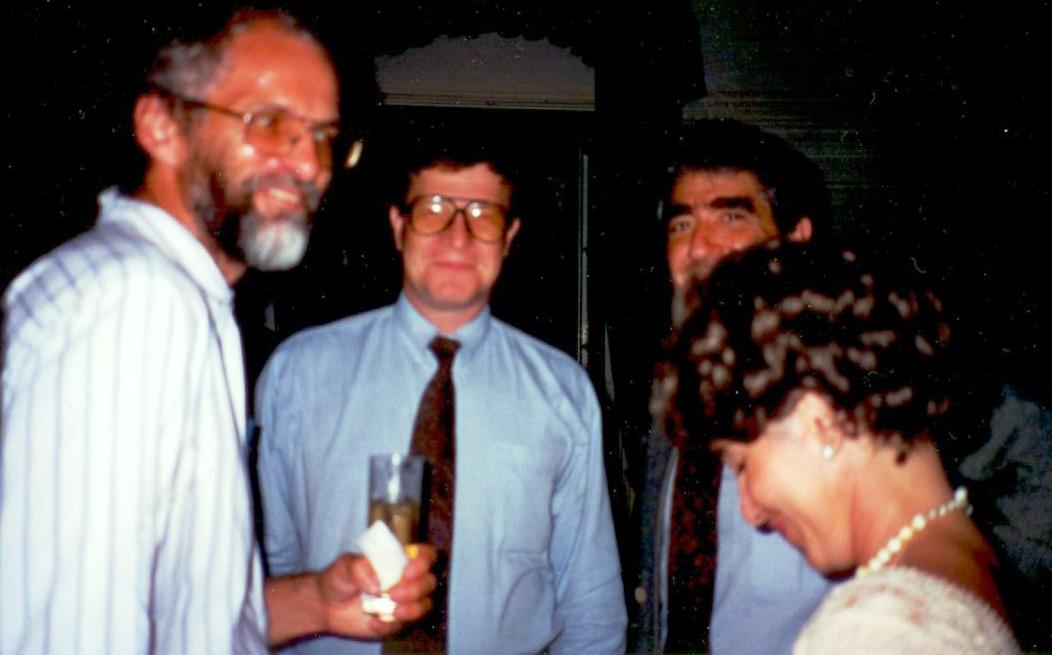 Gary McMahon, Ambassador Mark Entwisle, Francisco Leon, and Lourdes Tabares
Gary McMahon, Ambassador Mark Entwisle, Francisco Leon, and Lourdes Tabares
Nicholas Rowe, teaching a Macroeconomics class, October 1994 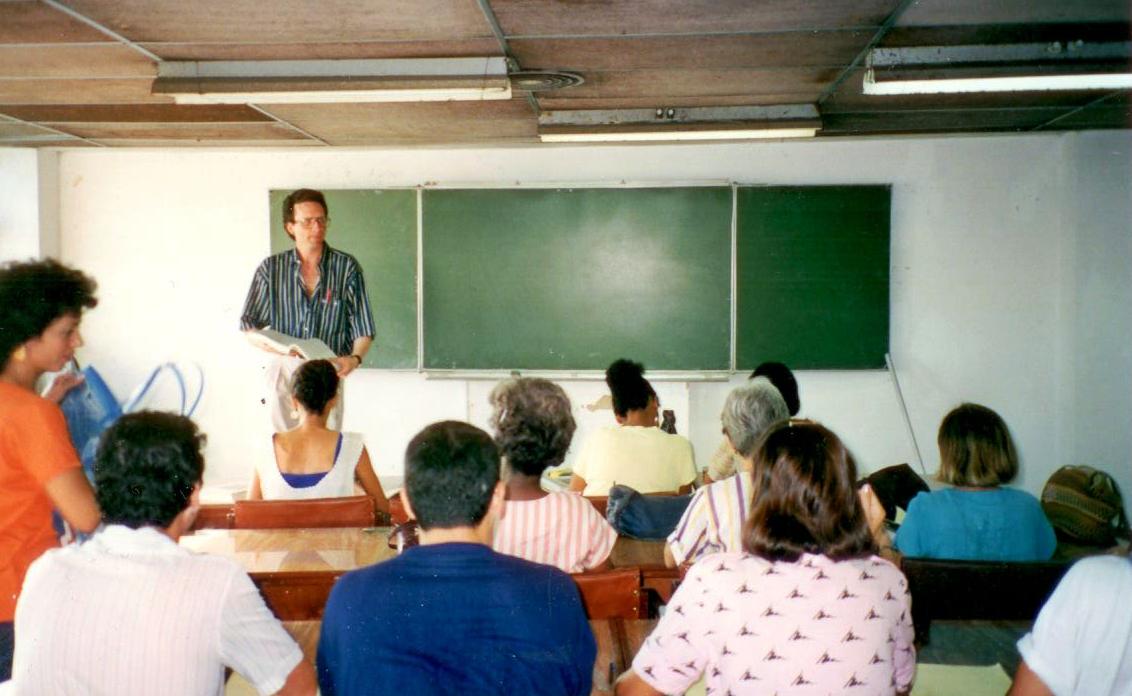
Class of 1996-1997 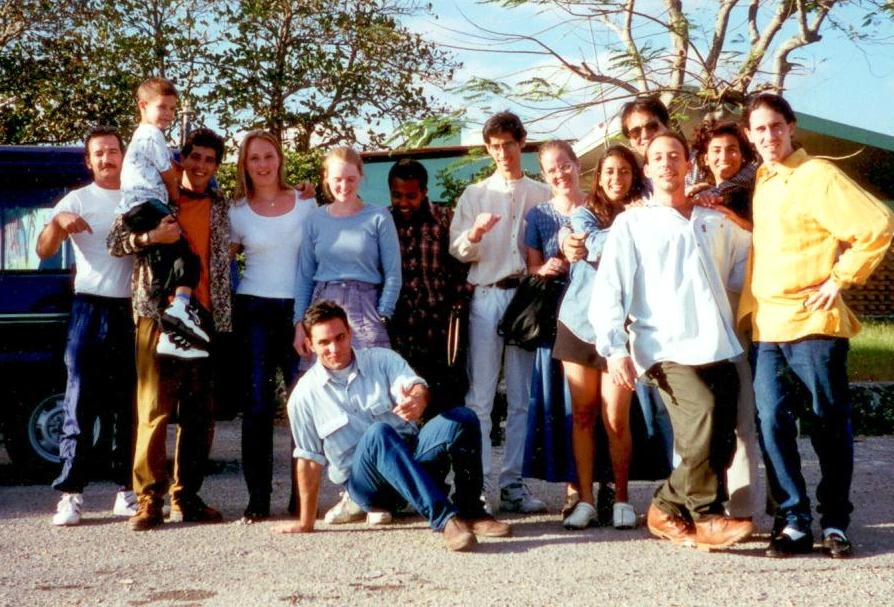 From left to Right: Nicki; Nicki’s son Junior, (Canadian, not known), Elizabeth Rohr (Carleton University), Rene Mujica, Victor Sombert, Luciano Rondon, Ana Julia Yanes Faya, Mahe Parodi, Karel Regalado, E. V. Diaz, Judith Rodriguez, Yuri Gracia,
From left to Right: Nicki; Nicki’s son Junior, (Canadian, not known), Elizabeth Rohr (Carleton University), Rene Mujica, Victor Sombert, Luciano Rondon, Ana Julia Yanes Faya, Mahe Parodi, Karel Regalado, E. V. Diaz, Judith Rodriguez, Yuri Gracia,
Class of 1997-1998 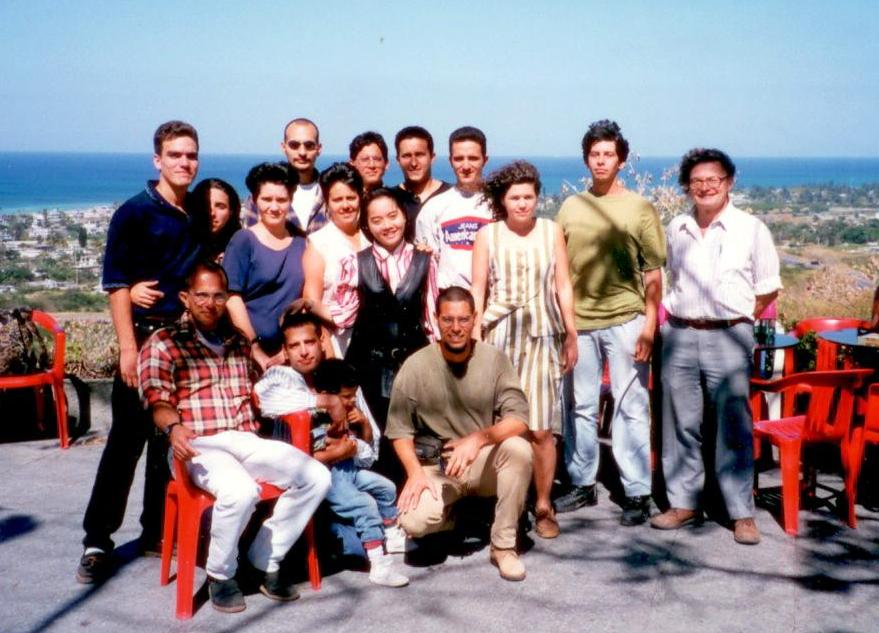 From left to right, Back: Osmel Martinez, Yaimi Farias Dominguez, Raysa Alcala, Ernesto Landa, Belkis, Alberto Baly, Alina, Paul Valdes-Miranda, Tran Thang Huong, Esteban Salido, Eileen Tur, Alexis Aguilera and Arch Ritter. In front: Ricardo Mansilla, Adrian Denis with Luis Casaco’s son Mauri and Luis Casaco, Guabano, February 1998
From left to right, Back: Osmel Martinez, Yaimi Farias Dominguez, Raysa Alcala, Ernesto Landa, Belkis, Alberto Baly, Alina, Paul Valdes-Miranda, Tran Thang Huong, Esteban Salido, Eileen Tur, Alexis Aguilera and Arch Ritter. In front: Ricardo Mansilla, Adrian Denis with Luis Casaco’s son Mauri and Luis Casaco, Guabano, February 1998
Class of 1998-1999 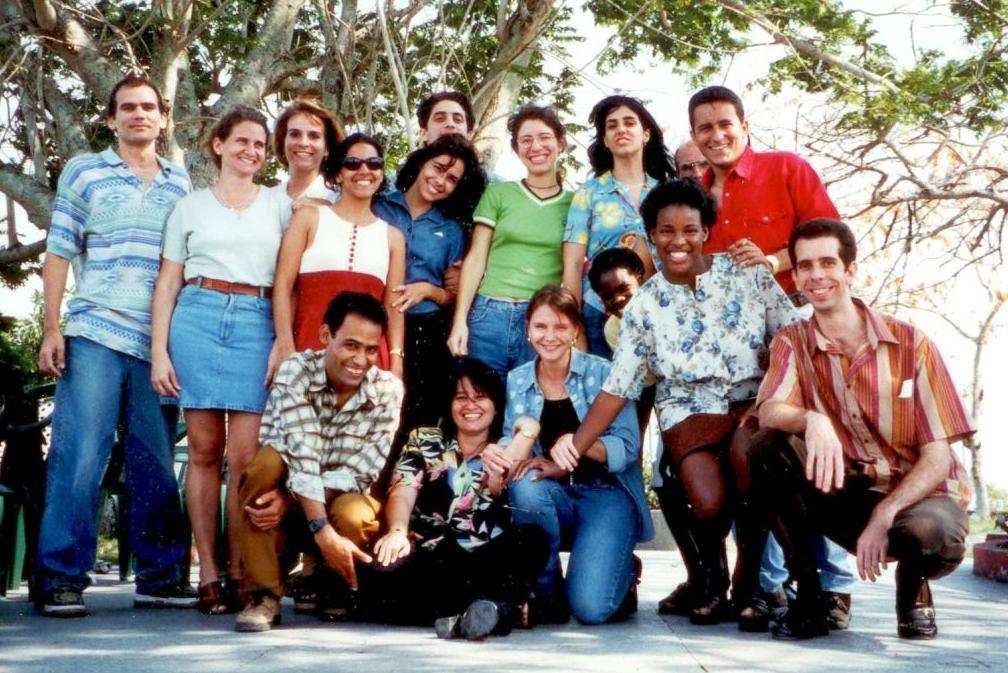 Front row. left to right: M. Bachra-Ahmed, Maritza Alvarez, Maria Boiko, Kim Frederick, Tatiana Gonzalez, Marcos Diaz Diaz Back row: Radamez Gonzalez, Vilma Cervantes, Zoe Medina, Katty Yeja, Mavis Morales, Eduardo Ramos, Heidi Portuondo, Ana Margarita Perez. Luis Gutierrez, Paul Valdes-Miranda
Front row. left to right: M. Bachra-Ahmed, Maritza Alvarez, Maria Boiko, Kim Frederick, Tatiana Gonzalez, Marcos Diaz Diaz Back row: Radamez Gonzalez, Vilma Cervantes, Zoe Medina, Katty Yeja, Mavis Morales, Eduardo Ramos, Heidi Portuondo, Ana Margarita Perez. Luis Gutierrez, Paul Valdes-Miranda

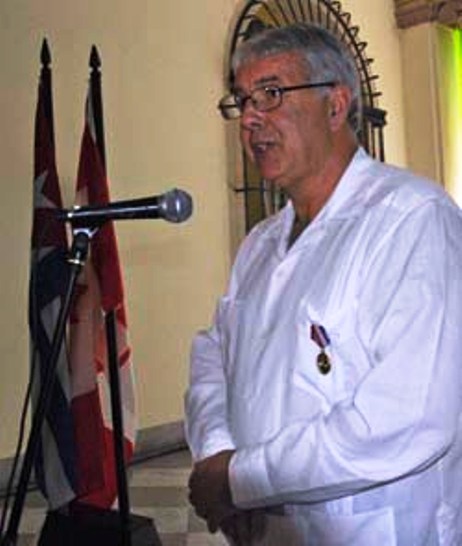
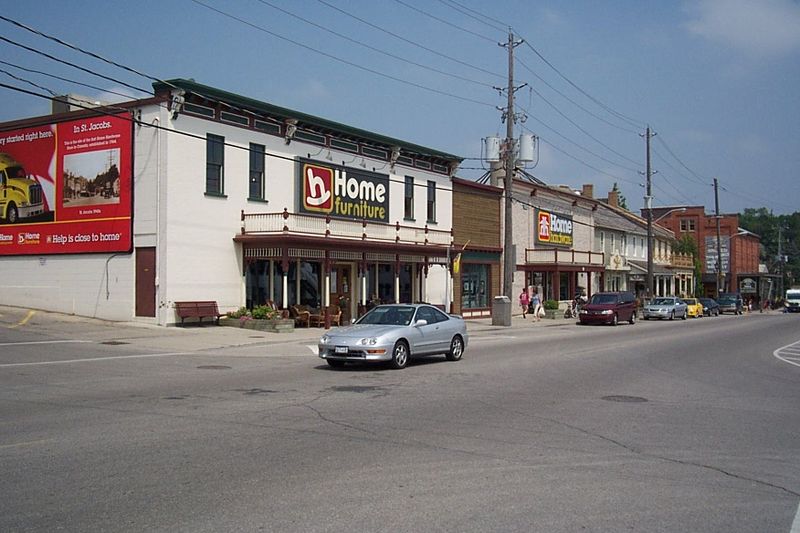
![TIENDADELCIMEX[1]](https://thecubaneconomy.com/wp-content/uploads/2011/10/TIENDADELCIMEX1.jpg)


